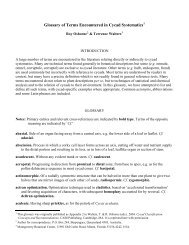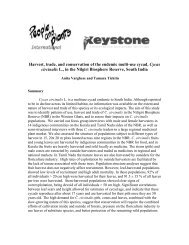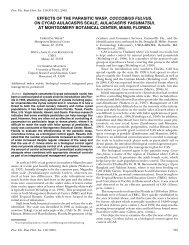Emshousen,C., C. Mannion & H. Glenn. 2004
Emshousen,C., C. Mannion & H. Glenn. 2004
Emshousen,C., C. Mannion & H. Glenn. 2004
Create successful ePaper yourself
Turn your PDF publications into a flip-book with our unique Google optimized e-Paper software.
Table 2. Percent mortality and percent females with all dead eggs from<br />
densely infested cycad species.<br />
Plant<br />
C. media<br />
S. eriopus<br />
C. angulata<br />
C. bougainvilleana<br />
C. edentata<br />
C. taitungensis<br />
C. riuminiana<br />
C. thouarsii<br />
C. edentata<br />
Percent female<br />
mortality<br />
Percent females<br />
with all dead eggs<br />
90 90<br />
90 89<br />
80 80<br />
80 79<br />
75 74<br />
70 70<br />
70 70<br />
65 65<br />
40 35<br />
erage. Researchers have found that the plant architecture of<br />
cycads can sometimes prevent the applicator from being able<br />
to direct a spray to all infested portions of a plant (Hodges et<br />
al., 2003). We found that plants with branch/leaf architecture<br />
or size that made it difficult to spray all parts of the plant<br />
showed less control of scale on densely infested areas of the<br />
plant such as leaf bases. Similarly, areas of the plant that have<br />
become densely infested and have layers of dead scale on top<br />
of live scale may have made it difficult for the chemical to penetrate<br />
the layers and control the live scale. Pyriproxifen may<br />
provide the best control when plants are treated regularly to<br />
Proc. Fla. State Hort. Soc.<br />
117:307-309. <strong>2004</strong>.<br />
control scale and dead scale are washed from the plant so layers<br />
of dead scale are not allowed to build up.<br />
In the future we need to continue to examine the period<br />
of effective control of CAS after a treatment and determine<br />
the optimal application times. Additional studies are also<br />
needed to establish the effect of pyriproxifen on natural enemies<br />
and the level of control that can be obtained by using pyriproxifen<br />
and biological control organisms in an integrated<br />
pest management system.<br />
Literature Cited<br />
<strong>Emshousen</strong>, C. and C. <strong>Mannion</strong>. <strong>2004</strong>. Taming Asian cycad scale. The Cycad<br />
Newsletter 27(1).<br />
Hodges, G., F. W. Howard, and E. A. Buss. 2003. Update on management<br />
methods for cycad aulacaspis scale. Dept. of Agriculture and Consumer<br />
Services-Entomology Section.<br />
Howard, F. W., A. Hamon, M. Mclaughlin, T. Weissling, and S-L. Yang 1999.<br />
Aulacaspis yasumatsui (Hemiptera: Sternorrhyncha: Diaspididae), a scale<br />
insect pest of cycads recently introduced into Florida. Florida Entomologist<br />
82(1).<br />
Howard, F. W., T. Weissling, and D. Hull. 1996. New armored scale insect introduction<br />
in Miami area. TropicLine 9(2).<br />
Marler, T. <strong>2004</strong>. Fighting back. Pacific Daily News. 13 March.<br />
Walters, T., E. Shroyer, and L. Anderson. 1997. Scale and south Florida Cycas<br />
The Cycad Newsletter 20(1).<br />
Weissling, T. J., F. W. Howard, and A. B. Hamon. 1999. Cycad aulacaspis scale,<br />
Aulacaspis yasumatsui Takagi (Insecta: Homoptera: Sternorrhyncha: Diaspididae).<br />
Florida Coop. Ext. Service Publication document EENY-096. July.<br />
INTEGRATED PEST MANAGEMENT IN PINELLAS COUNTY NURSERIES<br />
JOHN<br />
C. A<br />
1 LLEYNE AND<br />
MARIA<br />
University of Florida, IFAS<br />
Pinellas County Extension<br />
Largo, FL 33774<br />
M. A 2 PGAR<br />
Additional index words. outreach programs, Pinellas county<br />
extension<br />
Abstract. In 2000, Pinellas County Extension embarked on using<br />
innovative methods to reintroduce Integrated Pest Management<br />
(IPM) to Pinellas County Nurseries. A web page<br />
showcasing IPM basic definitions, methods and techniques<br />
was developed and an informal outreach-teaching program<br />
implemented in 2002. In 2003, IPM pilot programs were established<br />
in collaborating nurseries. Growers had the assistance<br />
of a cooperating entomologist, visiting nurseries on a weekly<br />
basis; scouting for pests and proposing treatments following<br />
IPM principles. A database was developed to store information<br />
and monitor progress of each grower. Data regarding pest<br />
population levels and outcome of treatments were stored. In<br />
<strong>2004</strong>, Pinellas County nursery growers are successfully imple-<br />
1Commercial<br />
Horticulture Agent. Pinellas County Extension Service.<br />
2Independent<br />
IPM consultant. P.O. Box 76087 St. Petersburg, FL 33704.<br />
menting IPM programs, controlling pests, reducing pesticide<br />
output and impacting environmental sustainability.<br />
Integrated Pest Management or IPM is a combination of<br />
multiple control methods to reduce pests, while lowering the<br />
number of chemical pesticide applications. IPM has been<br />
proven to lower environmental risks and lower crop production<br />
costs (Olkoski et al., 1991). Ornamental plant growers of<br />
Pinellas County, Fla., have little knowledge of IPM or are<br />
skeptical about the outcome of implementing IPM practices<br />
in their nurseries. Successful IPM programs for containergrown<br />
plants are in place in the neighboring counties of Hillsborough<br />
and Manatee (Melton and Shyves, <strong>2004</strong>).<br />
Pinellas County Extension is committed to helping growers<br />
in the transition from traditional pest control practices to<br />
more environmentally friendly pest control. As more pesticides<br />
are banned due to environmental concerns, growers<br />
need to learn new ways to control insect and mite pests. Pinellas<br />
County Extension has devised a strategy that promotes a<br />
gradual process to implement IPM in ornamental nurseries in<br />
the county. The strategy consists of three steps: generating<br />
awareness, pilot programs, and continuous assistance to growers<br />
implementing IPM programs.<br />
Proc. Fla. State Hort. Soc. 117: <strong>2004</strong>. 307






